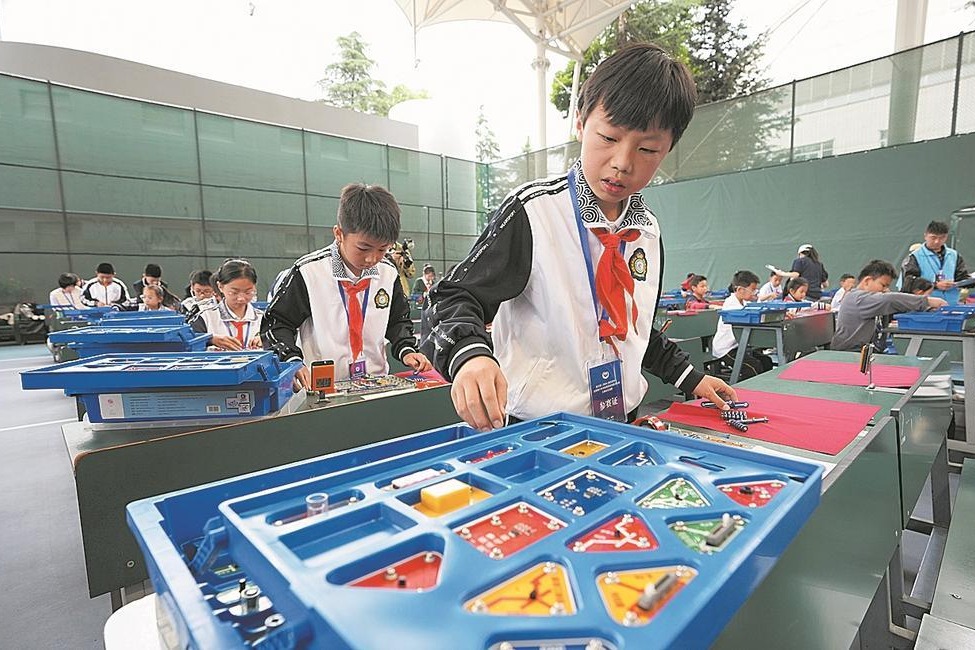Remembering a titan Hungarian architect

|

Park Hotel stands in West Nanjing Road in Shanghai. Designed by Laszlo Hudec, the hotel has been a landmark in the city for half a century. Dou Wa / for China Daily |
Shanghai government plans to turn Laszlo Hudec’s english countryside residence into a museum
If there is someone to blame for the ever-growing skyline in Shanghai, it must be Laszlo Hudec, the Hungarian architect who designed China's first high-rise, the 84-meter-tall, 22-floor Park Hotel.
Many residents still consider the 78-year-old building a landmark of sorts, especially as it towered the Asian skylines for over two decades till 1952, and also represents much of Shanghai over the past 50 years.
For Shanghai, Hudec is no ordinary architect. Though his work extends much beyond the Park Hotel, it is the landmark structure for which he is best known. Not only was Hudec responsible for deciding the height of the hotel, but also for its rich and vibrant Oriental Parisian decor.
Hudec also breathed life to several other landmark buildings in Shanghai like the Grand Theatre, Moore Memorial Church and Paramount Ballroom. Recognizing his contributions to the city, the Shanghai government has now decided to convert his residence into a museum commemorating his life and work in the city.
"We are now working on the renovation project with the government. It will showcase the life Hudec led in Shanghai between 1931 to 1937, the peak of his career," says Ern Klmn, chairman of the Hungarian Architecture Association.
Klmn incidentally was in Shanghai recently to kick off the Hungarian Modern Architecture exhibition in the city.
Hidden in a quiet street in the former French Concession, Hudec's residence resembles more of a rustic English countryside villa with three floors and over 10 rooms. Its roof, made up of crimson-colored slab tiles, covers almost half of the height of the structure, and also features two red brick chimneys.
Although the interiors are in a state of disarray due to prolonged periods of neglect and disrepair, the spacious rooms within are well equipped with all facilities and bathrooms. Striking features like large fireplaces and huge walk-in closets are tell tale signs of the rich legacy left behind by Hudec.
"It's hard to tell how much Hudec had invested in this residence. It is probably the only one he designed and lived in along with his family in Shanghai," says Hua Xiazhong, a professor from Architecture and Urban Planning College of Tongji University, who studied Hudec's architecture for her masters degree.
"But it must have been a huge investment considering its beautiful layout and solid structure that requires little repair even after decades' of rains and storms," says Hua.
According to Klmn, the villa, encompassing an area of 800 square meters, will undergo extensive renovation work from this summer so that it can be finished by the end of this year.
Currently, the renovation project is still at a paperwork stage, with five companies having put in bids for the contract.
Klmn expects the English countryside house to be restored to its past glory and thrown open to the public both as a museum in memory of Hudec and as a venue for lectures and activities.
But it still remains a mystery how the house will eventually turn out, as the local government, the current owner of the property, is keeping a low profile on the project and refuses to either confirm or deny the "expectation".
"When it comes to 'heritage architecture' (a title given to the house by the Shanghai municipality in 2005), you just can't expect it to be easy if any alteration is made," says Li, the housekeeper.
Li says before his arrival, the house had been deserted for years after being used as a government office during the 1990's and had, practically, become a shelter for tramps. Some of the tramps still come, once in a while, to sleep by breaking the windows or simply lifting the door off its hinges.
But for Klmn, the biggest problem is to restore the house to its past glory, even as it strives to maintain perfect harmony in a modern neighborhood.
Today's Top News
- Xi encourages young sinologists to bridge China, the world
- Xi, president of Comoros exchange congratulations on 50th anniversary of ties
- Luxury leasing market gains traction in HK
- Historic games forge deeper bonds beyond podium
- Technology will ensure future heroes save lives and live
- Auto market rides high on NEV sales growth






























